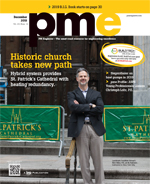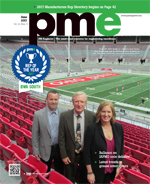
At A Glance
Years with Jaros Baum & Bolles:1966 to presentYears as a professional engineer:1973 to present [licensed in 13 states]
Years as a fire protection engineer:1974 to present
Years as a certified value engineer:1974 to present
Career Highlights: Assisted in the design of: World Trade Center, Sears Tower [Chicago], Bank of China [Hong Kong], the Brigham and Women’s Hospital [Boston], Four Seasons Hotel [New York], the New York Stock Exchange. Participated in the US/USSR joint meetings on both internal and external utility systems sponsored by HUD. Served on the Board of Mechanical Engineering Consultors at Manhattan College and was an adjunct professor at Stevens/NYU for 10 years. Started and led the JB&B college recruiting program. Also served on the board of Directors of the ASPE Research Foundation.
Currently: Retired in early 2008, but serves as a consultant for JB&B. Is a member of the Managing Committee for the development of the new New York City Building Code and Chairman of the Plumbing Code Sub Committee. Also serves on the Board of Directors of the New York City Fire Museum and is a member of the USGBC Water Efficiency Technology Advisory Group.
Do you have an area of specialty at your firm?
In 1980, I became head of the plumbing and fire protection department at JB&B and continued in that capacity until my retirement from the partnership in early 2008. As head of the department, I was responsible for conceptualizing with my staff the plumbing and fire protection systems of all the projects commissioned by JB&B. Before that, I performed hydraulic design calculations then designed wastewater treatment plants as well as desalination plants for hotels in the Mideast. Also, I became the solid waste handling systems specialist.How prevalent is green design/LEED certification in your daily work? Can you mention a few projects of note in this area?
Much of what we do in the area of green plumbing design we have done in the past. Ranging from the capture and reuse of storm water well as steam condensate for cooling tower makeup, to the use of steam condensate to preheat domestic water, we have used these systems in many of our buildings prior to the “green” era.Some projects of note are 7 WTC, a gold-rated office building and One Bryant Park, the Bank of America Building in New York City that will be the first high-rise speculative office building to achieve a LEED Platinum rating. All tenants in the building, including Bank of America, will be LEED TI gold rated. All of the projects at Ground Zero are being designed to achieve at least a gold rating. At One Bryant Park we utilize staggered storm water and condensate capture tanks in the Tower to allow the capture and reuse of this water by gravity to flush toilet fixtures in the building thus not only saving water but energy as well. This building also utilizes waterless urinals throughout. These systems will result in a savings of almost 70% of all water use in the building, including cooling tower use.
Have you participated in any plumbing/fire protection designing of any of the World Trade Center properties, specifically the Towers 1-4, Sept. 11 Memorial/Museum, and Transit Hub?
As department head, I participated in the conceptual and preliminary designs of all these projects - including the development of the Basis of Design for the entire site. These buildings will be the most advanced buildings in the world with respect to safety and fire protection. The fire protection systems have been designed and thought out with sufficient redundancy to safeguard, to the extent possible, a disaster as occurred on 9/11 from occurring again. The fire protection system design in these buildings have led to many of the changes in the new New York City Code. I feel that my career has a very different twist in that I started my career working on the original World Trade Center and finished my career in the development of the new World Trade Center.What are the greatest challenges plumbing engineer/designers face today?
Technically, it will be the requisite designs to continue to provide safe and well-engineered systems that conserve a vital natural resource. The conservation of water, the required lessening of the impact of wastewater on our environment in a safe and intelligent manner are at the forefront of our industry. We must never forget that our industry was founded on the basis of supplying clean and healthy water to the general population and to safeguard the health and well being of the population and our planet with the proper disposal and treatment of wastewater. It will be a fine balance to continue these goals with the pressures to conserve and the greening of our environment.I am very much concerned with the decentralization of wastewater plants and their attendant maintenance, operation and regulation. If we do go for decentralization, we must make sure that projects are properly staffed, that the systems are well maintained and constantly monitored. We must never forget the basic tenet of our industry – proper plumbing safeguards the communities’ health. I think the future of our industry will be very exciting and challenging. When this economy stabilizes and starts to improve, a loggerhead of new construction will be removed and project schedules will be demanding.
Technology seems to be improving almost on a daily basis. Keeping up with the technological improvements, the future demands of clients for new designs, economic constraints of the projects and the ongoing environmental constraints will continue to challenge engineers. I think for these reasons that, going forward, our profession will have a bright and exciting future.



